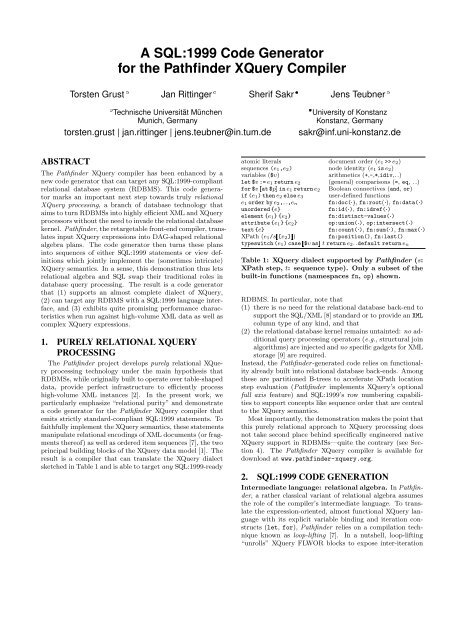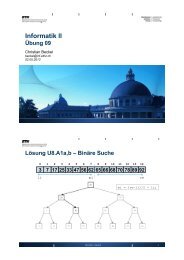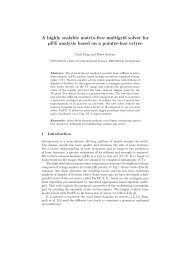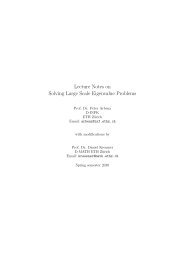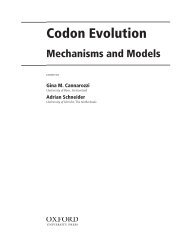A SQL:1999 Code Generator for the Pathfinder XQuery ... - CiteSeer
A SQL:1999 Code Generator for the Pathfinder XQuery ... - CiteSeer
A SQL:1999 Code Generator for the Pathfinder XQuery ... - CiteSeer
You also want an ePaper? Increase the reach of your titles
YUMPU automatically turns print PDFs into web optimized ePapers that Google loves.
A <strong>SQL</strong>:<strong>1999</strong> <strong>Code</strong> <strong>Generator</strong><br />
<strong>for</strong> <strong>the</strong> <strong>Pathfinder</strong> <strong>XQuery</strong> Compiler<br />
Torsten Grust ¥ Jan Rittinger ¥ Sherif Sakr � Jens Teubner ¥<br />
¥ Technische Universität München<br />
Munich, Germany<br />
torsten.grust | jan.rittinger | jens.teubner@in.tum.de<br />
ABSTRACT<br />
The <strong>Pathfinder</strong> <strong>XQuery</strong> compiler has been enhanced by a<br />
new code generator that can target any <strong>SQL</strong>:<strong>1999</strong>-compliant<br />
relational database system (RDBMS). This code generator<br />
marks an important next step towards truly relational<br />
<strong>XQuery</strong> processing, a branch of database technology that<br />
aims to turn RDBMSs into highly efficient XML and <strong>XQuery</strong><br />
processors without <strong>the</strong> need to invade <strong>the</strong> relational database<br />
kernel. <strong>Pathfinder</strong>, <strong>the</strong> retargetable front-end compiler, translates<br />
input <strong>XQuery</strong> expressions into DAG-shaped relational<br />
algebra plans. The code generator <strong>the</strong>n turns <strong>the</strong>se plans<br />
into sequences of ei<strong>the</strong>r <strong>SQL</strong>:<strong>1999</strong> statements or view definitions<br />
which jointly implement <strong>the</strong> (sometimes intricate)<br />
<strong>XQuery</strong> semantics. In a sense, this demonstration thus lets<br />
relational algebra and <strong>SQL</strong> swap <strong>the</strong>ir traditional roles in<br />
database query processing. The result is a code generator<br />
that (1) supports an almost complete dialect of <strong>XQuery</strong>,<br />
(2) can target any RDBMS with a <strong>SQL</strong>:<strong>1999</strong> language interface,<br />
and (3) exhibits quite promising per<strong>for</strong>mance characteristics<br />
when run against high-volume XML data as well as<br />
complex <strong>XQuery</strong> expressions.<br />
1. PURELY RELATIONAL XQUERY<br />
PROCESSING<br />
The <strong>Pathfinder</strong> project develops purely relational <strong>XQuery</strong><br />
processing technology under <strong>the</strong> main hypo<strong>the</strong>sis that<br />
RDBMSs, while originally built to operate over table-shaped<br />
data, provide perfect infrastructure to efficiently process<br />
high-volume XML instances [2]. In <strong>the</strong> present work, we<br />
particularly emphasize “relational purity” and demonstrate<br />
a code generator <strong>for</strong> <strong>the</strong> <strong>Pathfinder</strong> <strong>XQuery</strong> compiler that<br />
emits strictly standard-compliant <strong>SQL</strong>:<strong>1999</strong> statements. To<br />
faithfully implement <strong>the</strong> <strong>XQuery</strong> semantics, <strong>the</strong>se statements<br />
manipulate relational encodings of XML documents (or fragments<br />
<strong>the</strong>reof) as well as ordered item sequences [7], <strong>the</strong> two<br />
principal building blocks of <strong>the</strong> <strong>XQuery</strong> data model [1]. The<br />
result is a compiler that can translate <strong>the</strong> <strong>XQuery</strong> dialect<br />
sketched in Table 1 and is able to target any <strong>SQL</strong>:<strong>1999</strong>-ready<br />
� University of Konstanz<br />
Konstanz, Germany<br />
sakr@inf.uni-konstanz.de<br />
atomic literals<br />
sequences (e1,e2)<br />
variables ($v)<br />
document order (e1 >> e2)<br />
node identity (e1 is e2)<br />
arithmetics (+,-,*,idiv,. .)<br />
let $v := e1 return e2 (general) comparisons (=, eq, . .)<br />
<strong>for</strong> $v �at $p� in e1 return e2 Boolean connectives (and, or)<br />
if (e1) <strong>the</strong>n e2 else e3 user-defined functions<br />
e1 order by e2,. .,en<br />
fn:doc(¤�, fn:root(¤), fn:data(¤)<br />
unordered {e} fn:id(¤), fn:idref(¤)<br />
element {e1} {e2} fn:distinct-values(¤)<br />
attribute {e1} {e2} op:union(¤), op:intersect(¤)<br />
text {e} fn:count(¤), fn:sum(¤), fn:max(¤)<br />
XPath (e1/s�[e2]�) fn:position(), fn:last()<br />
typeswitch (e1) case �$v as� t return e2. .default return en<br />
Table 1: <strong>XQuery</strong> dialect supported by <strong>Pathfinder</strong> (s:<br />
XPath step, t: sequence type). Only a subset of <strong>the</strong><br />
built-in functions (namespaces fn, op) shown.<br />
RDBMS. In particular, note that<br />
(1) <strong>the</strong>re is no need <strong>for</strong> <strong>the</strong> relational database back-end to<br />
support <strong>the</strong> <strong>SQL</strong>/XML [8] standard or to provide an XML<br />
column type of any kind, and that<br />
(2) <strong>the</strong> relational database kernel remains untainted: no additional<br />
query processing operators (e.g., structural join<br />
algorithms) are injected and no specific gadgets <strong>for</strong> XML<br />
storage [9] are required.<br />
Instead, <strong>the</strong> <strong>Pathfinder</strong>-generated code relies on functionality<br />
already built into relational database back-ends. Among<br />
<strong>the</strong>se are partitioned B-trees to accelerate XPath location<br />
step evaluation (<strong>Pathfinder</strong> implements <strong>XQuery</strong>’s optional<br />
full axis feature) and <strong>SQL</strong>:<strong>1999</strong>’s row numbering capabilities<br />
to support concepts like sequence order that are central<br />
to <strong>the</strong> <strong>XQuery</strong> semantics.<br />
Most importantly, <strong>the</strong> demonstration makes <strong>the</strong> point that<br />
this purely relational approach to <strong>XQuery</strong> processing does<br />
not take second place behind specifically engineered native<br />
<strong>XQuery</strong> support in RDBMSs—quite <strong>the</strong> contrary (see Section<br />
4). The <strong>Pathfinder</strong> <strong>XQuery</strong> compiler is available <strong>for</strong><br />
download at www.pathfinder-xquery.org.<br />
2. <strong>SQL</strong>:<strong>1999</strong> CODE GENERATION<br />
Intermediate language: relational algebra. In <strong>Pathfinder</strong>,<br />
a ra<strong>the</strong>r classical variant of relational algebra assumes<br />
<strong>the</strong> role of <strong>the</strong> compiler’s intermediate language. To translate<br />
<strong>the</strong> expression-oriented, almost functional <strong>XQuery</strong> language<br />
with its explicit variable binding and iteration constructs<br />
(let, <strong>for</strong>), <strong>Pathfinder</strong> relies on a compilation technique<br />
known as loop-lifting [7]. In a nutshell, loop-lifting<br />
“unrolls” <strong>XQuery</strong> FLWOR blocks to expose inter-iteration
data parallelism which <strong>the</strong> compiler <strong>the</strong>n maps onto <strong>the</strong><br />
bulk-processing primitives of relational algebra. This choice<br />
of intermediate language has its particular strengths. On <strong>the</strong><br />
one hand, <strong>the</strong> semantics of relational algebra are well-defined<br />
and independent of any particular database back-end. <strong>Pathfinder</strong><br />
back-ends <strong>for</strong> <strong>the</strong> MonetDB column-oriented RDBMS<br />
and <strong>the</strong> Idefix XML-aware file system layer are described in<br />
[2] and [4], respectively. On <strong>the</strong> o<strong>the</strong>r hand, <strong>the</strong> algebraic<br />
primitives model <strong>the</strong> internals of RDBMS query engines sufficiently<br />
exact such that <strong>the</strong> generation of efficient code remains<br />
feasible. To fur<strong>the</strong>r facilitate <strong>the</strong> latter, <strong>Pathfinder</strong>’s<br />
relational algebra adheres to restrictions that are inspired<br />
by <strong>the</strong> actual processing capabilities of <strong>SQL</strong>-centric database<br />
kernels: column projection (π) does not eliminate duplicate<br />
rows, <strong>for</strong> example.<br />
The resulting loop-lifted algebraic plans typically exhibit a<br />
wealth of sharing opportunities and thus are maintained as<br />
plan DAGs. <strong>Pathfinder</strong> makes aggressive use of relational<br />
properties—e.g., keys, functional and multi-valued dependencies,<br />
inclusion of active attribute domains—to reduce<br />
<strong>the</strong> size of <strong>the</strong> plan DAGs (cutting down <strong>the</strong> typical operator<br />
count of 30–300 by more than 50 %) and to realize o<strong>the</strong>r plan<br />
enhancements. A number of non-trivial <strong>XQuery</strong>-specific optimizations<br />
are compactly described using relational algebra.<br />
In algebraic plans derived by loop-lifting, a robust, nonsyntactical<br />
detection of value-based joins in <strong>XQuery</strong> may<br />
be based on a simple analysis of multi-valued dependencies<br />
[5] and an elegant implementation of unordered { } and<br />
fn:unordered() can be <strong>for</strong>mulated in terms of projection<br />
pushdown [6].<br />
Target language: <strong>SQL</strong>:<strong>1999</strong>. Due to <strong>the</strong> compositionality<br />
of <strong>the</strong> <strong>XQuery</strong> language in which all constructs nest<br />
orthogonally as long as typing rules are obeyed, plan shapes<br />
significantly diverge from <strong>the</strong> well-known π–σ–� pattern<br />
generated by <strong>SQL</strong> compilers. This observation led to a code<br />
generation approach where <strong>the</strong> algebraic plans are chopped<br />
to let <strong>the</strong> RDBMS back-end evaluate <strong>the</strong> overall plan in separate<br />
chunks.<br />
To identify suitable plan chunks, <strong>the</strong> code generator walks<br />
<strong>the</strong> plan DAG to find basic blocks—straight-line operator sequences<br />
with no sideways entries—much like compilers <strong>for</strong><br />
programming languages. Inside <strong>the</strong>se basic blocks, <strong>Pathfinder</strong><br />
applies template instantiation to collapse groups of<br />
adjacent operators: a template describes a group of algebraic<br />
operators that can be equivalently implemented by a<br />
single <strong>SQL</strong> statement.<br />
<strong>Pathfinder</strong> issues <strong>SQL</strong>:<strong>1999</strong> code in one of three modes:<br />
(1) each instantiated template is compiled into a <strong>SQL</strong>:<strong>1999</strong><br />
statement that, upon execution, populates a temporary<br />
result table exempt from logging or o<strong>the</strong>r transactional<br />
overhead (strategy in Figure 1),<br />
(2) instantiations are compiled into <strong>SQL</strong>:<strong>1999</strong> view definitions<br />
plus a single query that drives evaluation (strategy<br />
), or<br />
(3) instantiations yield <strong>SQL</strong>:<strong>1999</strong> view definitions as in (2)<br />
except when <strong>the</strong> code generator decides that a group of<br />
view definitions leads to a nested <strong>SQL</strong> query so complex<br />
that intermediate materialization as in (1) is beneficial<br />
(strategy ).<br />
The statements are assembled into a <strong>SQL</strong> script whose execution<br />
evaluates <strong>the</strong> input <strong>XQuery</strong> expression. Note that<br />
both, shared temporary tables as well as view definitions,<br />
<strong>SQL</strong> Construct Used by/<strong>for</strong> (Remarks)<br />
ROW_NUMBER() OVER (<br />
implementation of <strong>XQuery</strong><br />
PARTITION BY a ORDER BY b) order semantics<br />
UNION ALL item sequence construction<br />
� RIGHT OUTER � JOIN (predominantly equi-joins)<br />
aggregates (SUM(), MAX(), . . . ) maintain node encoding<br />
range conditions XPath location step evaluation<br />
type casting (CAST a AS τ) polymorphic item sequences<br />
(non-logged) temporary tables full materialization strategy<br />
nested queries in FROM clauses basic block <strong>for</strong>ming<br />
Table 2: Excerpt of <strong>SQL</strong> constructs used by <strong>the</strong> code<br />
generator (a,b: column names, τ: <strong>SQL</strong> data type).<br />
can reflect <strong>the</strong> substantial degree of sharing in <strong>the</strong> DAGshaped<br />
algebraic plans emitted by <strong>the</strong> compiler front-end.<br />
Table 2 lists some of <strong>the</strong> <strong>SQL</strong>:<strong>1999</strong> constructs used by <strong>the</strong><br />
code generator. The resulting <strong>SQL</strong> queries are reasonably<br />
“good-natured”, e.g., all UNION operations are over disjoint<br />
tables, nested queries in FROM clauses are uncorrelated, and<br />
most of <strong>the</strong> occurring JOIN operators are equi-joins that implement<br />
<strong>the</strong> behavior of nested <strong>for</strong>-iteration scopes [7]. Fur<strong>the</strong>r<br />
θ-joins are only introduced by <strong>XQuery</strong> join detection<br />
(see above).<br />
In <strong>the</strong> <strong>XQuery</strong> data model, ordered finite sequences of<br />
items are pervasive. The code generator employs<br />
<strong>the</strong> <strong>SQL</strong>:<strong>1999</strong> ROW_NUMBER() OLAP ranking primitive<br />
to create and manipulate tabular representations<br />
of such ordered sequences. In <strong>Pathfinder</strong>, row<br />
ranks are interpreted as sequence positions (column<br />
pos) [1] as depicted here in <strong>the</strong> relational encoding<br />
of <strong>the</strong> item sequence (i1,i2,. . . ,in). It is<br />
critical that ROW_NUMBER()-based orderings are encoded in<br />
<strong>the</strong> data itself and thus may be communicated from statement<br />
to statement (which would be impossible with <strong>SQL</strong>’s<br />
ORDER BY construct).<br />
Most perceivable implementations of ROW_NUMBER() introduce<br />
blocking sort operations in <strong>the</strong> final physical query execution<br />
plans. <strong>Pathfinder</strong>’s optimizer thus invests considerable<br />
ef<strong>for</strong>t to avoid row numbering wherever this is possible,<br />
<strong>for</strong> example in <strong>the</strong> scope of unordered { }, <strong>the</strong> existential<br />
semantics of general comparisons (=,
� Execution Time [ms]<br />
10 6<br />
10 5<br />
10 4<br />
10 3<br />
10 2<br />
10 1<br />
897<br />
2880<br />
1572<br />
5260<br />
24580<br />
19394<br />
33757<br />
3318<br />
7910<br />
473<br />
1743<br />
3<br />
308<br />
13<br />
1014<br />
141030<br />
210773<br />
180562<br />
261110<br />
120212<br />
157450<br />
381203<br />
533788<br />
403612<br />
543119<br />
Q1 Q2 Q3 Q4 Q5 Q6 Q7 Q8 Q9 Q10 Q11 Q12 Q13 Q14 Q15 Q16 Q17 Q18 Q19 Q20<br />
XMark Benchmark Query<br />
130194<br />
39180<br />
1252<br />
6270<br />
1<br />
58<br />
34628<br />
1216<br />
1616<br />
2907<br />
2125<br />
4484<br />
2052<br />
17429<br />
19344<br />
19202<br />
5251<br />
3182<br />
8197<br />
423<br />
Materialize?<br />
if complex<br />
never<br />
full<br />
Figure 1: Elapsed times <strong>for</strong> <strong>the</strong> 20 XMark queries ran against a 115 MB XML instance (� 5,000,000 nodes)<br />
hosted by DB2 9. The <strong>SQL</strong> code generator has been configured to apply different materialization strategies.<br />
have indeed found XPath location step evaluation to account<br />
<strong>for</strong> only a minor fraction of <strong>the</strong> overall query processing<br />
time [6]. Access patterns which are specific to <strong>the</strong><br />
plans produced by <strong>the</strong> <strong>SQL</strong>:<strong>1999</strong> code generator, e.g., node<br />
access by column level or by element tag name, are readily<br />
supported by secondary partitioned B-tree indexes [3]. A<br />
low-selectivity key prefix partitions <strong>the</strong> encoding and quickly<br />
guides B-tree lookups to find only relevant nodes. The code<br />
generator can optionally take advantage of DataGuide-style<br />
path summaries which may also be realized in terms of partitioned<br />
B-trees: all nodes represented by a common node in<br />
<strong>the</strong> DataGuide reside in <strong>the</strong> same partition. Effectively, each<br />
such B-tree partition materializes <strong>the</strong> result of an absolute<br />
XPath location path.<br />
To benefit from <strong>the</strong>se indexes even in <strong>the</strong> presence of<br />
nodes that a query may construct at runtime—<strong>the</strong>se transient<br />
nodes do not appear in any index—<strong>the</strong> system maintains<br />
<strong>the</strong> relational encodings of persistently stored XML<br />
documents and transient XML fragments in separate tables.<br />
Since <strong>the</strong> evaluation of an XPath location step never escapes<br />
<strong>the</strong> tree fragment of its context node, we can fully benefit<br />
from indexing whenever steps are evaluated against persistent<br />
nodes (which is <strong>the</strong> common case) [7].<br />
Once query evaluation is complete, a database client can<br />
per<strong>for</strong>m a single sequential scan over <strong>the</strong> result table to serialize<br />
<strong>the</strong> final XML output.<br />
4. DEMONSTRATION SETUP<br />
Figure 1 depicts <strong>the</strong> elapsed query execution times <strong>for</strong> <strong>the</strong><br />
20 queries of <strong>the</strong> XMark benchmark [10] when <strong>the</strong> <strong>Pathfinder</strong>-generated<br />
<strong>SQL</strong>:<strong>1999</strong> scripts were executed on top of<br />
IBM DB2 9 1 . The reported times include <strong>SQL</strong> parsing and<br />
plan generation—<strong>the</strong> scripts contain 10–100 statements per<br />
benchmark query—but omit serialization. On <strong>the</strong> very same<br />
database host and workload, we have found <strong>Pathfinder</strong> to<br />
use about 1 �5 to 1 �3 of <strong>the</strong> time required by pureXML R○ , <strong>the</strong><br />
database kernel-resident <strong>XQuery</strong> engine operating on native<br />
XML storage that has been introduced in DB2 9 [9]. We<br />
firmly believe that <strong>the</strong> purely relational approach to <strong>XQuery</strong><br />
deserves to be pursued fur<strong>the</strong>r.<br />
Note that <strong>the</strong> longer execution times <strong>for</strong> Q8 through Q12<br />
are due to <strong>XQuery</strong> joins that inevitably produce substantial<br />
1 The database host was Linux-based and equipped with two<br />
3.2 GHz Intel Xeon R○ CPUs, 8 GB of primary and 280 GB<br />
SCSI disk-based memory.<br />
intermediate XML results (e.g., more than 31,500,000 nodes<br />
<strong>for</strong> Q11 ). For <strong>the</strong>se queries, pureXML R○ could not complete<br />
evaluation within a time frame of a few hours.<br />
Side-by-side on DB2 9: Purely Relational <strong>XQuery</strong><br />
and pureXML R○ . The live demonstration will feature a<br />
side-by-side setup of <strong>Pathfinder</strong> and <strong>the</strong> pureXML R○ <strong>XQuery</strong><br />
processor on DB2 9. The database will be populated with<br />
persistent XML documents of varying schema and size—once<br />
relationally encoded, once imported into <strong>the</strong> native XML<br />
storage. Users may evaluate ad-hoc <strong>XQuery</strong> expressions or<br />
run canned queries on both systems. Hooks will be installed<br />
in <strong>Pathfinder</strong> and DB2 9 to allow <strong>the</strong> inspection of <strong>the</strong> result<br />
of various compilation stages (relational algebra plan DAGs,<br />
<strong>SQL</strong>:<strong>1999</strong> scripts, physical execution plans).<br />
5. REFERENCES<br />
[1] S. Boag, D. Chamberlin, M. F. Fernández,<br />
D. Florescu, J. Robie, and J. Siméon. <strong>XQuery</strong> 1.0: An<br />
XML Query Language. W3 Consortium, June 2006.<br />
[2] P. Boncz, T. Grust, M. van Keulen, S. Manegold,<br />
J. Rittinger, and J. Teubner. MonetDB/<strong>XQuery</strong>: A<br />
Fast <strong>XQuery</strong> Processor Powered by a Relational<br />
Engine. In Proc. SIGMOD, Chicago, USA, 2006.<br />
[3] G. Graefe. Sorting and Indexing with Partitioned<br />
B-trees. In Proc. CIDR, Asilomar, CA, USA, 2003.<br />
[4] C. Grün, A. Holupirek, M. Kramis, M. H. Scholl, and<br />
M. Waldvogel. Pushing XPath Accelerator to its<br />
Limits. In Proc. EXPDB, Chicago, USA, 2006.<br />
[5] T. Grust. Purely Relational FLWORs. In Proc.<br />
XIME-P Workshop, Maryland, USA, 2005.<br />
[6] T. Grust, J. Rittinger, and J. Teubner. eXrQuy:<br />
Order Indifference in <strong>XQuery</strong>. In Proc. ICDE,<br />
Istanbul, Turkey, 2007.<br />
[7] T. Grust, S. Sakr, and J. Teubner. <strong>XQuery</strong> on <strong>SQL</strong><br />
Hosts. In Proc. VLDB, Toronto, Canada, 2004.<br />
[8] International Standards Organization (ISO).<br />
In<strong>for</strong>mation Technology—Database Language <strong>SQL</strong>,<br />
2003.<br />
[9] M. Nicola and B. van der Linden. Native XML<br />
Support in DB2 Universal Database. In Proc. VLDB,<br />
Trondheim, Norway, 2005.<br />
[10] A. R. Schmidt, F. Waas, M. L. Kersten, M. J. Carey,<br />
I. Manolescu, and R. Busse. XMark: A Benchmark <strong>for</strong><br />
XML Data Management. In Proc. VLDB, Hong Kong,<br />
China, 2002.


